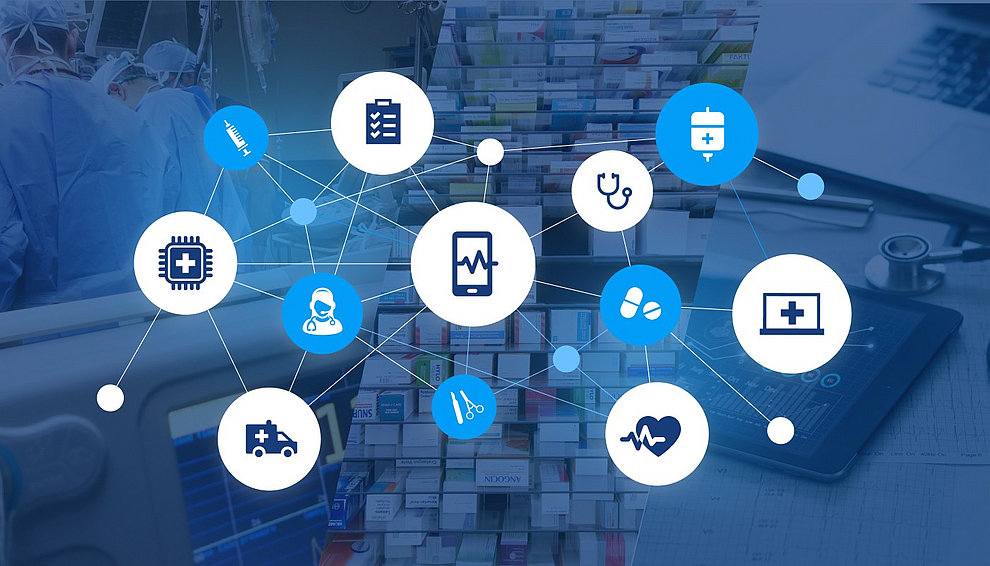Get in touch


Hospitals, health insurance companies, medical product and pharmaceutical manufacturers are courting the favor of potential customers and patients. Regarded until recently as a pure marketing discipline, digital experience management (DX or DXM) has become a critical factor in the battle for customers.
Who designs the customer journey the most efficiently across all touchpoints? Who manages to respond quickly and competently to customer inquiries on all relevant channels? Who will succeed in networking patients and service providers in the healthcare sector efficiently and in compliance with data privacy regulations?
It’s clear: The German healthcare sector is in a state of flux. Players who want to compete successfully in this sector must exploit the enormous potential of a “person-centered” digitalization. But don’t panic. It’s neither necessary to rethink your own business model radically all at once for this, nor do you have to know how to hack your way through the complex jungle of customer-oriented processes, technological possibilities, optimal organization of customer service, and interfaces to other systems and organizations. Once again here, the motto is think big, start small, move fast. Making adjustments step-by-step and according to plan and maintaining an overview has proven to be much more promising than the digitalization big bang. However, you have to be proactive and make the necessary changes as quickly as possible. Here, we have identified four fields of potential for actors in health care to help them along their individual path to the digital people journey.
Everyone started somewhere. Digital experience management has its roots in the classic marketing sector. In order to develop new approaches, methods, and possibilities, flows are mapped digitally end-to-end according to the way users see things. An essential aspect here is the changed communication behavior. Patients don’t want to wait a long time, be handed along from person to person, or told when via which channel or on which devices they must communicate; they would rather decide this according to the situation at hand. It’s also important to ensure that strict data privacy requirements are fulfilled.
Even if all of this seems a bit overwhelming at first glance, it is possible to address all target groups with an omnichannel platform with a “patient-centered” front end that is interoperable and complies with data privacy regulations. The development focus for such a digital health care platform should on the one hand be data collection and entry in order to concentrate on creating value for the customers; on the other hand, a comprehensively conceived front end with a very good user experience (UX). Customers should be picked up on their digital journey in user-friendly fashion with sensible, current information so that they feel they are never alone in the process.
A good practical example is the ePA, electronic patient files, which are supposed to contribute to optimized health care thanks to the digital exchange of health-related information between patients, doctors, specialists, and pharmacists. Life gets especially interesting if actual added value services are offered in connection with the ePA. For example, e-prescriptions will be available [in Germany] starting in January 2022. For the first time, all participants across all disciplines will be integrated into the process, creating a true end-to-end process without interruptions. Surely the ePA conceals a lot of untapped potential with regard to the UX, but it’s a start.

For the healthcare sector, “digitalization” means more than just data. Only with smart connections is the information in the virtual space accessible. That’s why “enhanced connectivity” stands not only for the physical connection, but also for a connection that includes the logic as well as overarching, open, secure, and digital communication. Specifically, the attractively designed front end is coupled to back-end systems via open interfaces (APIs). The goal is a digital ecosystem for all actors that enables the cooperation of different systems and organizations with common standards. Here, a smooth exchange, the centralized collection and enrichment of data from and for patient care, and a networking of the different partners (e.g. patients, health insurance companies, manufacturers of medical products, hospitals, pharmaceutical manufacturers, service providers, and doctors) is guaranteed.
A recent development is the first approved digital health care applications (DiGAs) that doctors can prescribe (“app on prescription,” https://diga.bfarm.de/de/verzeichnis). There are a lot of different target groups: Among other things, there is a diabetes app, one for people who are obese, and there are also numerous apps in the psychotherapeutic sector. DiGAs can be integrated and networked in many ways. They automatically provide the doctor in charge with relevant information about the patient’s state of health and treatment progress; it is also possible to make appointments with the apps. At the same time, patients can access the offerings of relevant third parties, such as the online shops of medical device manufacturers that produce blood sugar measurement equipment. The long-term goal: To get a 360-degree view of the customer and allow various participating parties to interact with one another – for the good of the patient and to make the service providers’ lives easier.
Adaptability is a central element of digital strategies. Operators of digital platforms should therefore make sure during the implementation that the technological platforms remain flexible and scalable. It must be possible to adapt the people journey to the situation at hand. That’s why the trend is toward modular systems that are composed individually of functional building blocks. The talk here is of “composable” architectures where data and services in the back end are separated systematically from the front end. All components in such a network are connected via APIs.
This way, more and more building blocks can be joined, and you remain flexible with regard to all external influencing factors. These can be changes in the general flows, e.g. incoming emergency cases in case of hospital stays, new insights into medication interactions, or changing global trends, to name just a few examples.
First business, then pleasure: Thanks to prediction and machine learning methods, it’s not just workflows, but also complex diagnostics that are automated and standardized. Systems learn to evaluate process flows when they are used every day, and they can optimize themselves. This leads to improved processes that result in a long-term reduction of providers’ administrative work. AI is the key technology for digitalizing health care; it enables the transformation of health care, the development of precision medicine, and improved patient experiences. With state-of-the-art imaging technology and DNA sequencing processes, today diseases can be diagnosed earlier and more precisely than ever before. For example, the Hasso Plattner Institute is already developing models for detecting disease patterns in MRI images and molecular data and describing them statistically using large quantities of data.
The topic of prediction and machine learning offers especially great possibilities for medical device manufacturers. Based on experiential values and sensors attached to devices, precise predictions can be made about the wear of individual components, and ideally their automatic exchange can be initiated. Thanks to state-of-the-art technology, this predictive maintenance enables the “Internet of Things" (IoT), which networks physical and virtual objects around the world with one another.
At the moment in Germany, one the one hand, there are technological peak performances to be admired in some specialized areas such as medical technology; on the other hand, from the customers’ and patients’ point of view, things are a patchwork and there are few comprehensive digital solutions in sight that are thought all the way through. In the long term, digital experience management in health care will have to offer more than just electronic records. One of the biggest hurdles for a fantastic customer experience in health care is often the lack of a comprehensive view of the customer or user in question. If you want to inspire people with digital health care platforms, these platforms have to be able to map universal access to all health transactions and all of a patient’s interactions with the various service providers. For this, the actors in health care have to converge their services and form ecosystems to enable industry-spanning cooperation with health technology providers, for example. The path toward this goal can only be blazed in harmony with data privacy guidelines since medical data is rightly subject to a high level of protection. And don’t forget: In all of this, the person is the focus, regardless of his or her role: patient, caretaker, doctor, administrator, or something else. When the focus is on the person, the digital journey should be designed so that it is as pleasant, easy, and efficient as possible.